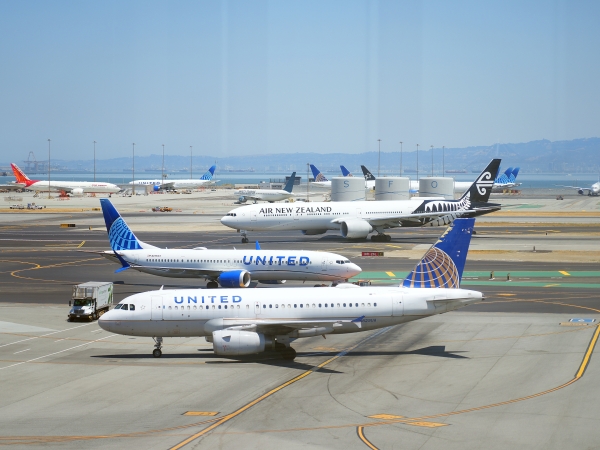The average flight today from Kennedy Airport to LAX is slower than it was in 1995 in every conceivable way. Planes face longer delays leaving the gate; take more time taxiing before taking off; and spend more time in the air.
But paradoxically, even with an average rise in travel time of 18 minutes, the percentage of flights on this route arriving after the scheduled arrival time has decreased. In 1995, the arrivals were behind schedule 51% of the time; today it’s just 37%.
Why do today’s flights arrive early more often, even though they’re slower? Airlines have extended their scheduled flight durations even more than the flights have lengthened in actual duration. The average scheduled duration from JFK to Los Angeles has increased by 23 minutes since 1995, according to a New York Times analysis of Bureau of Transportation Statistics data.
Thanks to those more forgiving schedules, a majority of domestic flights nationwide arrive early or on time. If your plane reaches the gate at exactly the estimated arrival time, you are actually on a plane that is running slower than usual.
For airlines, scheduling the extra time has little downside, while it has the upside of looking good in on-time performance data and avoiding customer scorn.
“It’s called padding,” said Chad Kendall, a former commercial pilot and an associate professor of aviation at Metropolitan State University of Denver. He said airlines had plenty of incentives to be on time, especially on paper.
“The benchmark for performance set by the Department of Transportation is based on arriving within 15 minutes of your scheduled time of arrival,” he said. Airlines are protective of their reputation; business travelers in particular care about arriving on time.
When things go wrong, they go wrong
It is less common now for flights to be moderately delayed. About 30% of flights last year were delayed by up to one hour, compared with over 45% three decades ago.
At the same time, the percentage of very delayed flights has increased. Whether we use 90 minutes or three hours as a cutoff, the number of meaningfully late flights is likely to set a record this year.
Lavanya Marla, a professor of systems engineering at the University of Illinois, said that as airlines have optimized their day-to-day operations, especially with scheduling flight crews, it has also led to more instances of major disruptions that cascade throughout the system.
“If you build the schedule well, you’re able to do the same task with fewer crews,” she said. “When it works, it’s fantastic. But when you have an unexpected event happen, you don’t necessarily have slack in the schedule.”
A more efficient system allows for more flights without building more runways. But it has also created more traffic for individual flights. The average taxi-out time for LaGuardia Airport flights is now 24 minutes compared with 19 minutes three decades ago. In some ways, the small increase is impressive given that LaGuardia departures are up 64% in that time while using its same two runways.
Long taxi times are a small factor compared with flights that don’t depart the gate on time. If your plane does leave the gate on time, you are essentially ahead of schedule. Last year, 75% of flights that left the gate exactly on time arrived at their destinations early.
Patrick Smith, author of the blog Ask the Pilot and a commercial pilot for more than 30 years, said the data reflected his experiences: “If you leave Los Angeles on time, you’re pretty much guaranteed to get to New York a bit early.”
Right before a flight, he said, pilots are given a timetable based on weather conditions and air traffic. The arrival time on the pilot’s timetable will be different — usually earlier — than the arrival time on your ticket.
What can you do?
A record number of passengers is expected this holiday season. Unfortunately, there are limited options if your goal is to spend as little time traveling as possible.
You could pay for a more expensive seat so that you can deplane faster. You could pay for TSA PreCheck to spend less time getting through security. And you could choose to fly an airline that has a proven record of fewer delays, although it will typically cost more.
If you don’t want to spend additional money, there is one trend that’s good to know. Flights that take off in the early evening are nearly three times as likely to be significantly delayed as those in the early morning.
The tight interdependency of scheduling means flights in the evening can be delayed if earlier flights have issues. Flights in the morning, which benefit from nightly schedule resets, are less likely to suffer the same problems.
If you want to minimize lateness, it’s more important to consider departure time than airline. Spirit Airlines has indeed had more long delays than Delta Air Lines over the last five years, but a flight on Spirit that departs at 6 a.m. is less likely to be significantly delayed than a flight on Delta that takes off in the evening.
That said, some airlines stand out for not sticking to their schedules. Among large airlines, JetBlue is one of the worst offenders. Its early flights have been delayed around 3% of the time in recent years, but its evening flights have been late more than 10% of the time, a rate significantly above its rivals.
This article originally appeared in The New York Times.

